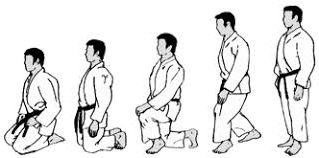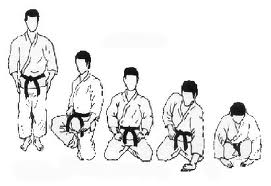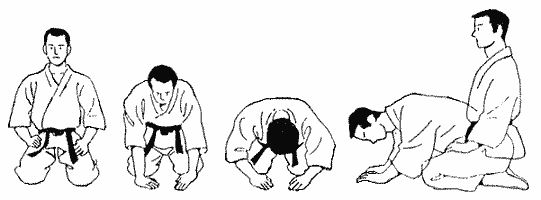One is to kneel down without moving your feet (the way I do). I start with the left knee going down first then followed by the right knee. I know this method is hard for many people as it requires the strong legs and good balance. During the process of sitting down and standing up you must hold your upper body as erect as possible and not to bend over which can be challenging for some beginners. It can be very challenging even for the senior practitioners to perform a smooth and graceful zarei in the ritual.
During the kneeling process, do not put your hand or hands down to support yourself. If you have a knee problem then you must ask your sensei for permission to do this. Some older practitioners may be allowed to stand due to difficulties with their knee or leg. Normally, you must keep your hands at your sides or laps during this process. This will allow you to correctly kneel down into the seiza position.
Let’s take a look at how this bowing needs to be performed. To do zarei correctly there are three groups of movements:
- Sitting down
- Bowing itself
- Standing up
1.Sitting down
- Start from musubi dachi (heels touching and toes open) stance
- The next move is somewhat difficult but you need to squat down slowly and bring your left knee down (your knee will fall forward as your feet do not move (shown in illustration).
- Pivot your right foot and bring down your right knee and when both knees touch the floor you will assume temporarily tsumasaki dachi position. Extend your feet and cross slightly before you sit in seiza. The hands are kept at your side then place them gently on the laps as you assume seiza.

Getting into kneeling (sezia) position from yoi (musubi dachi)
2.Bowing itself
- Place left hand in front of the left knee, then place your right hand in front of the right knee. When the both hands are placed on the floor, your upper body inclines naturally forward.
- Bow by bending at the hips until the upper body inclines 45 to 60 degrees but be sure to keep you back straight. After 1 to 3 seconds of bowing retrieve your right hand back first then follow with your left hand and return to seiza position with your back erect and eye sight straight forward.
3. Standing up from seiza
- Bring your toes up and assume tsumasaki dachi position first.
- Bring up your right knee up stepping up with your right foot forward and assume left leg kneeling position.
- Stand up and step your right foot back to meet left foot to make musubi achi stance.
What about the hands?
From a seiza position, the image below shows that you should put your left hand on the floor first while keeping your right hand on your lap. Then you will put your right hand down. This is the samurai way and this is how I've been doing it from day one.

Putting the left hand down first
However, putting both hands down at the same time is also acceptable since we no longer carry swords. It is up to the individual Karateka to decide if he/she wants to do a samurai way or the modern way.

Putting both hands down at the same time
The four key points to follow for your zarei:
1. Do not lift your buttocks as you bow. In other words, you must keep your buttocks on your feet at all time during the za rei process.
2. Keep your back straight and do not arch your back as you bow.
3. The best angle for a teacher is 45 degrees.
4. The students can bow as low as 90 degrees. Do not bow too deeply.
Standing Bow


